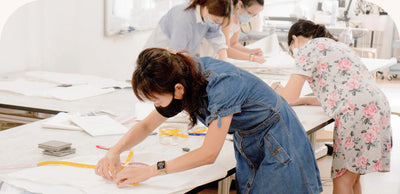
The Sewing Trend: Dying or Reviving?
Being someone who is interested in sewing, you probably have googled ‘sewing classes in Singapore’, ‘sewing for beginners’, ‘sewing machine for beginners’, but have you tried ‘Sewing history’?
The history of sewing started out of obvious necessity, with people sewing fur and skin clothing using bone, antler or ivory needles and “thread” made of various animal body parts including sinew, catgut, and veins. We promise it’s not always so gory but here’s a quick read to introduce you to the fascinating history of sewing that started since the Stone Age!
Stone Age
Sewing has an ancient history and was first used to stitch together animal hides and parts for clothing and shelter. People used what they had access to – think animal hides, plants and leaves to sew what they needed.
Middle Age
Fast forward to the middle ages, sewing for the most part was a woman’s occupation. Women sewed to extend the longevity of clothing, which was an expensive investment for most people. Clothings were mended, turned inside out, reassembled. When they can no longer be mended, they were taken apart and the reusable cloth were made into new items of clothing or quilts. Which is what we would now call “Re-use & Recycle”.
Industrial Revolution
The sewing machine was patented in this era, and women continued to lead this industry. However, you will often find them in textile sweatshops as poorly paid seamstress, sewing ready-made clothes for the middle classes with sewing machine. They worked 14-hour days and could not even earn a living wage.
This was happening close to home, right in Singapore. Garment factories were plentiful in Singapore, with our grandmothers and/or mothers working in such factories. As time passed and economic development shifted, manufacturing shifted overseas and textile factories were closed. Many of Singapore’s seamstress started sewing from home, with bigger companies or individuals collecting garments straight from their homes. It was a form of income support but it did not pay a lot.
Now in the 21st century
What about now? In the 21st century where you and I are at? Where affordable fast fashion is ample and easily found. Do you think the sewing trend is dying, or reviving?
We saw the reviving trend of sewing. Sewing machines started to look more trendy, encased with plastic exteriors to make it lightweight and portable, which is great for our own smaller space-restricting homes. Four years in the making at Fashion Makerspace and we continued to see new and old friends who joined our classes and projects. Rather than being a trade for survival, sewing is now a fun, fulfilling hobby and skill that you choose to learn and hone.
Many of you have joined because sewing to you is exciting or therapeutic; you love the satisfaction of being able to create something personal for yourself or a loved one. Some of you sparked interest after seeing tutorials on YouTube or finished products from people you knew- thinking, “Wow I can learn to do this too!” Some saw the wide and growing selection of fabrics in stores like Spotlight, or came across the coveted fabric brand called Liberty. Many joined to be part of the sewing community we have here in Fashion Makerspace, where you get to meet like-minded people, express your creativity and dedicate time for yourself to do something you love.
Once, home sewing was perceived to be so archaic, time consuming and fraught with economic distinctions: the poor sewed, the rich bought. Now, it’s where we meet and grow as a community, with easy access to technology and fabrics that we need.
If you’re looking for a community of sewing lovers to join in Singapore, somewhere that allows close learning, direct feedback from friendly instructors, and the ability to customise and create your own designs.

